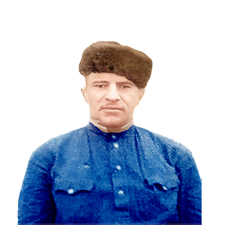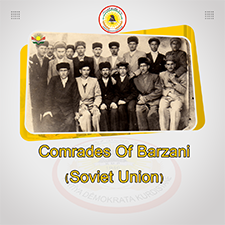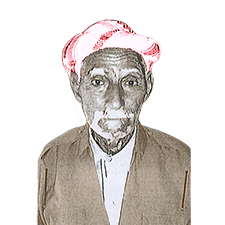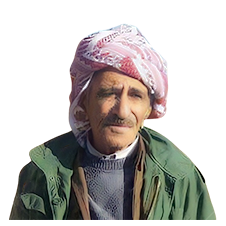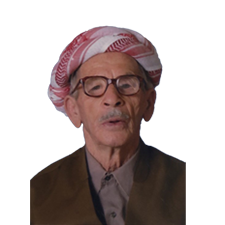Biography:
Khdr Issa Dolamari was born in 1927 in the village of “Giske” which was a part of Erbil. Following the fall of the first Barzani revolution, Shex Ahamdi Barzani along with many Barzani families traveled to northern Kurdistan. Khdr along with his family migrated to the Republic of Turkey in 1932. However, when Turkey hands Shex Ahmadi Barzani back to Iraq, Khdr’s family with most of the Barzani families return to southern Kurdistan.
Khdr Issa studied in the Soviet Union, and he got his bachelor’s degree in agriculture in the University of “Tashkand” in 1954. In the year 1959, he became an employee for the agricultural office of Erbil. Moreover, Because of his participation in the revolution of “Aylul”, he is forced to leave his job; however, he does return to his old job in 1970. Khdr spoke Kurdish, Arabic and Russian. He passed away on the 7th of June in 2005 in a hospital in the city of Tehran, and Khdr was buried in the village of “Giske”.
:Service Record
After the fall of the second Barzani revolution on the 11th of October 1945, Khdr travels to eastern Kurdistan. Furthermore, he joins the ranks of the Barzani army in The Republic of Kurdistan on 31st of March in 1946. Additionally, on the 29th of April of the same year, he fought in the battle of “Qaraw” in Saqz. Khdr also participated in the battles of “Shno” and “Naghada” in 1947. Also, he was one of those peshmergas on 19/4/1947 who went through the road of “Khwakurk u Dashti Baraz grawa” on the land of northern Kurdistan to return to “Sherwan” and “Mzuri”. After their return, General Mustafa Barzani on 15/5/1947 in the village of “Argush” conducted a meeting with his comrades and granted them the freedom in whether to stay or go to the Soviet Union. In the meeting, everyone decides to leave and go to the Soviet Union. On the 23rd of May in 1947, Khdr travels with General Mustafa to the Soviet Union and fights in the battles of “Gali Qtur” and the bridge of “Mako”. After a lot of hardships, on the 18th of June in 1947, Khdr was able to travel to the Soviet Union after passing through the Aras River which was between the borders of Iran and the Soviet Union.
After their arrival at the Soviet Union on the 19th of June in 1947 in the city of “Nakhchawan” in the Republic of Azerbaijan, all of the comrades were placed in a community that was surrounded by barbed wire. They were being monitored by the soldiers and were treated like hostages of war when it came to food and clothes. Afterwards, the Soviet government decided that the comrades should be divided into the places of “Aghdam”, “Lachin”, “Ayulax” and “Kalbajar” in the Republic of Azerbaijan. On the 10th of December in 1947, they were transported to a military camp on the lake of “Khazar” in the capital of the Republic of Mahabad, “Bakor”. On the 23rd of the same month, they were given military clothes and were trained by the officers of the republic 8 hours a day. On top of that, some of the comrades that were literate in Kurdish would teach the language for 4 hours a day.
After the ill-treatment of “Jaafar Baqrov” with the comrades, on the 29th of August in 1949, Barzani decides to transport his military camp from the republic of Mahabad to a “Chrchuk” community near the city of “Ashkand” which was the capital of Uzbekistan; there they continued their military practices.
In March of 1949, the comrades were divided into the villages of the Soviet Union and farms (where civilians would rent them from the governments and pay them back later). The comrades were working in these places.
After the revolution of the 14th of July in 1958 in Iraq and the return of General Mustafa Barzani on the 25th of February in 1959, Barzani and his comrades were granted full amnesty by the government.
Because of the creation of the Republic of Iraq in 1958 by Abdul Kareem Qasim, Khdr along with his comrades traveled back to Kurdistan with the ship “Grozya” through the harbor of “Basra” on the 16th of April in 1959.
Khdr participated in the revolution of “Aylul” in 1961. Moreover, Khdr participated in the battles of “Shush” (1961), “Sharmnay” (1961), “Barzan” (1963), “Bley” (1963), “Pirs” (1963), and “Sari Akre” (1963).
In 1974, Khdr traveled to “Akre” and fought in the battle of “Hassan Bag”. Afterward, because of the fall of “Aylul” revolution, he migrated to Iran and settled in the city of Kermanshah. Then Khdr participated in the revolution of “Gulan” and the battles of “Lolan”, “Dashti Barazgr”, “Akre”, and “Shexani”. Additionally, he participated in the battles of “Khwakurk” and “Khardan”. In 1991 he fought in the uprising and “Dastani Kore”. Moreover, in 1996 Khdr became a committee member in “Dolamari”.
In the 12th conference of Kurdistan democratic party (KDP), Khdr was given the medal of Barzani by the president Masoud Barzani for his bravery and participation in the revolutions and battles for the freedom of Kurdistan.
Sources:
-
حامید گهوههری، میدالیای بارزانی بهرزترین خهڵاتی ڕێزلێنان، بهرگی یهكهم، (ههولێر - چاپخانهی حاجی هاشم - ٢٠١٥ز).
-
حهمید گهردی، پوختهی مێژوونامه، چاپی یهكهم، (ههولێر - دهزگای چاپ و بڵاوكردنهوهی ئاراس - چاپخانهی وهزارهتی پهروهرده - ٢٠٠٤ز).
-
ژیاننامهی شههیدی سهركرده خدر عیسا دۆلهمهری، گۆڤاری دهنگی پێشمهرگه، ئۆرگانی مهكتهبی رێكخستنی پێشمهرگه، ژماره ٨٨، پیرمام، چاپخانهی رۆشنبیری، تهمووزی ٢٠٠٥ز.
-
شهعبان عهلی شهعبان، ههندێك زانیاری سیاسی و مێژوویی، چاپی سێیهم، (ههولێر - چاپخانهی رۆژههڵات - ٢٠١٣ز).
-
شهوكهت شێخ یهزدین، یۆبیلی زێڕینی پێشمهرگه، (پیرمام - چاپخانه خهبات - ١٩٩٦ز).
-
صالح یوسف صوفي، كرۆنۆلۆژیا كوردستانێ و جیهانێ، چاپا ئێكێ، بهرگێ دووێ، (دهۆك - چاپخانا پارێزگهها دهۆكێ - ٢٠١٣ز).
-
صالح یوسف صوفي، كرۆنۆلۆژیا كوردستانێ و جیهانێ، چاپا ئێكێ، بهرگێ سێ، (دهۆك - چاپخانا پارێزگهها دهۆكێ - ٢٠١٣ز).
-
عمر فاروقی، سردار دانا زندگی و مبارزات مرحوم ملا مصطفی بارزانی، چاپ دوم، (ههولێر - چاپخانهی وزارت آموزش و پرورش - ٢٠٠٢ز).
-
عهبدولڕهحمان مهلا حهبیب ئهبوبهكر، عهشیرهتی بارزان له نێوان ١٩٣١-١٩٩١، چاپی یهكهم، (ههولێر - چاپخانهی وهزارهتی رۆشنبیری - ٢٠٠١ز).
-
كاروان محهمهد مهجید، بارزانییهكان له مههابادهوه بۆ سۆڤێت، چاپی یهكهم، (سلێمانی - چاپخانهی پهیوهند - ٢٠١١ز).
-
گۆڤاری ههتاو، ژماره ١٥٤، ساڵی شهشهم، ههولێر، چاپخانهی كوردستان، ههینی، ١٥ نیسانی ١٩٥٩.
-
له یادداشتی فهرماندهی شههید حهسۆ میرخان ژاژۆكی، ٦٢ رۆژ لهگهڵ بارزانی دا چوونی بارزانییهكان بۆ یهكێتی سۆڤێت، چاپی یهكهم (ههولێر - چاپخانهی رۆشنبیری - ١٩٩٧ز).
-
لیث عبدالمحسن جواد الزبیدي، ثورة ١٤ تموز ١٩٥٨ في العراق، (بغداد - دارالرشید للنشر - ١٩٧٩م).
-
مسعود بارزانی، بارزانی و بزوتنهوهی رزگاریخوازی كورد ١٩٣١-١٩٥٨، (دهۆك - چاپخانهی خهبات - ١٩٩٨ز).
-
مسعود بارزانی، بارزانی و بزوتنهوهی رزگاریخوازی كورد ١٩٦١-١٩٧٥، بهرگی سێیهم، بهشی یهكهم، (ههولێر - چاپخانهی وهزارهتی پهروهرده - ٢٠٠٤ز).
-
مقداد شاسوار، پێشمهرگهی دێرین خدر عیسا بیروباوهڕ لهههموو جۆرهكانی چهك بههێزتره، گۆڤاری دهنگی پێشمهرگه، ئۆرگانی مهكتهبی رێكخستنی پێشمهرگه، ژماره ٣٤، پیرمام، چاپخانهی رۆشنبیری، تشرینی یهكهمی ٢٠٠٠ز.
-
نهجهف قولی پسیان، له مهابادی خوێناوییهوه ههتا لێوارهكانی ئاراس، و. شهوكهت شێخ یهزدین، چاپی یهكهم، (پیرمام - یۆبیلی زێڕینی پارتی دیموكراتی كوردستان - ١٩٩٦ز).
-
ئـ.د.ئـ، فایلی ژماره AI-10، لیستی ههڤاڵانی مستهفا بارزانی بۆ یهكێتی سۆڤێت، بهڵگهنامه لهلایهن سهگڤان هاڵۆ پێشكهش كراوه، ٢٠١٦ز.
-
ئـ.د.ئـ، فایلی ژماره AN-87، بهڵگهنامهی ههڤاڵی بارزانی خزر عیسا خزر، لهلایهن خۆشهوی خزر پێشكهش كراوه، پیرمام، ١٨ كانوونی دووهمی ٢٠٢٠ز.
-
ئـ.د.ئـ، فایلی ژماره HB-119، پارتی دیموكراتی كوردستان، بارهگای بارزانی، لێژنهی باڵای ناوچهی بارزان، فۆرمی خزر عیسا خزرعیسا، پیرمام، ١ تشرینی دووهمی ٢٠١٨ز.
-
ئـ.د.ئـ، فایلی ژماره ZB-180، دهقی چاوپێكهوتن لهگهڵ خوشهوی خدر عیسا لهلایهن نهزیره مێرگهسۆری، پیرمام، ١٨ كانوونی دووهمی ٢٠٢٠ز.




